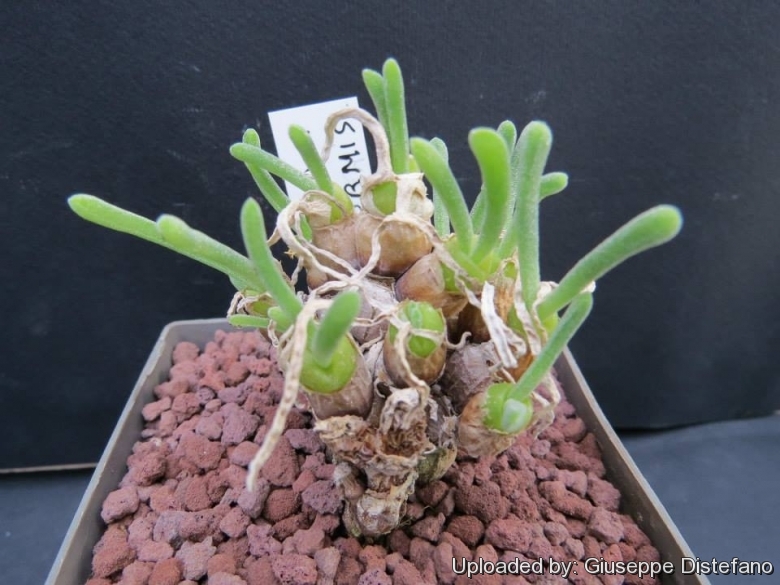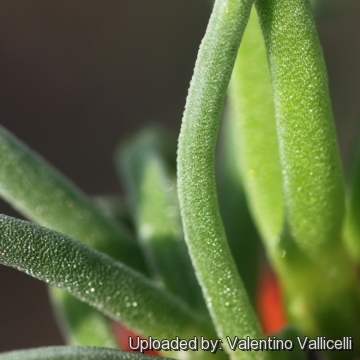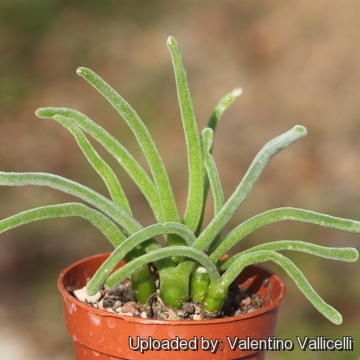Accepted Scientific Name: Monilaria pisiformis Schwantes
Gartenwelt 33: 69 1929

Schwantesia pisiformis (Monilaria pisiformis) Photo by: Giuseppe Distefano
Origin and Habitat: South Africa, Western Cape, Vredendal to Olifants River Mouth (Extent of occurrence less than 30 km² in two known locations).
Habitat and Ecology: Fynbos. It grows in the winter rainfall region in on quartz patches and in clay among quartzite along with Monilaria chrysoleucaSN|27070]]SN|27070]], Ruschia pygmaea and Cotyledon pygmaeaSN|35312]]SN|35312]]. Threatened by ongoing habitat loss to vineyards and tomato cultivation.
Synonyms:
Common Names include:
ENGLISH: String of pearls, Antenna plant
Description: Monilaria pisiformisSN|26030]]SN|26030]], commonly known as "strings of pearls", is a small clump-forming plants with thickish stems shortly jointed like a bead necklace. These plants are unlike any other in that each year one small bead-shaped leaf persists as the stem. Growing only one ”bead“ each year makes it very easy to guess how old a plant may be. In all parts Monilaria pisiformisSN|26030]]SN|26030]] is smaller than the other species.
Stem: Up to 12 cm tall, very branched with short branches, constricted at the nodes, joints longer than broad 4-9(-12) x 4-8 mm broad, internodes not visible, covered by leaf-sheath. Sheath persistent campanulate or doliform.
Leaves: The paired leaves are of two kinds and appear annually; the first pair forms a bag or sheath which is pushed open by the secondary leaves which are more conventional, being long, cylindric, and functional in making food and storing water. Expanded secondary leaves V-shaped, green, glossy papillose when young and will turn shades of red if exposed to higher light. Spaghetti-like, 5-6 cm long x up to 4 mm in diameter. The small glittering pearls on the leaves are special water storage cells rich in sugars characteristic of succulents, in Monilaria these cells may be ½ a mm in diameter and can retain their moisture for weeks when separated and exposed to dry air. In M. pisiformis, the leaf-sheath is cup-shaped and smaller than in the other species.
Flowers: Solitary, terminal 25-35 mm in diameter on a long pedicel. Sepals 5 unequal, papillose. Petals yellow with a white margin (also white, orange, salmon, red or purple), fading to white, and pink-reddish at the base. Stamens red but often different in colour, even if petals are pure white. Nectaries forming a continuous ring. Stigmas 5-7.
Fruits (capsules): 5-to 7-locular, 5-9 mm in diameter, the expanding keels diverging with narrow wings, covering membranes are present, closing bodies absent.
Seeds: Pointed at one end.
Chromosome number: 2n = 18
Bibliography: Major references and further lectures
1) Doreen Court "Succulent Flora of Southern Africa" CRC Press, 01/giu/2000
2) Helme, N.A. & Raimondo, D. 2007. Monilaria pisiformis (Haw.) Schwantes. National Assessment: "Red List of South African Plants" version 2013.1. Accessed on 2014/02/01
3) Gardeners' Chronicle 86: 33 1929
4) James Cullen, Sabina G. Knees, H. Suzanne Cubey "The European Garden Flora Flowering Plants: A Manual for the Identification of Plants Cultivated in Europe, Both Out-of-Doors and Under Glass" Cambridge University Press, 11/ago/2011
5) Heidrun E. K. Hartmann: "Illustrated Handbook of Succulent Plants: Aizoaceae F-Z." Springer Verlag, Berlin/Heidelberg/New York 2001
6) Gideon Smith. "Mesembs of the World: Illustrated Guide to a Remarkable Succulent Group." Briza Publications, 1998
7) H.-D. Ihlenfeld, S. Jörgensen: "Morphologie und Taxonomie der Gattung Monilaria (Schwantes) Schwantes s. str. (Mesembryanthemaceae)." In: Mitteilungen aus dem Institut für Allgemeine Botanik Hamburg. Volume 14: 49–94 1973
8) Cliff Fielding “Messing with Mesembs: Monilaria” in: Central Spine, Newsletter of the Central Arizona Cactus & Succulent Society, DECEMBER, 2009
 Schwantesia pisiformis (Monilaria pisiformis) Photo by: Valentino Vallicelli
Schwantesia pisiformis (Monilaria pisiformis) Photo by: Valentino Vallicelli Schwantesia pisiformis (Monilaria pisiformis) Photo by: Valentino Vallicelli
Schwantesia pisiformis (Monilaria pisiformis) Photo by: Valentino VallicelliCultivation and Propagation: It is relatively easy to grow. These plants grow on winter rain and head for summer dormancy. The growing season in northern hemisphere is from September to March. Water minimally in summer. Water regularly in winter after the new long green leaves appears at their extremities in autumn after the summer resting period. Requires good drainage. It enjoy some shade (avoid direct sun as it grows wild among rocks and under the shade of other plants) and in summer it need to be kept in a cool area. Hardy to -2°C. Ensure a very good ventilation. Avoid to repot frequently. This plant may stay in the same pot for many years. Plants grown in larger containers have frequently relatively poor flowers. It might improve when the plants are given their own, small individual pots.
Be careful not to apply too much fertilizer.
Propagation: It can be reproduced both by cuttings and seeds. Take the cutting from a grown-up mother plant. Each cutting must contain one or more branches along with a fraction of root.












